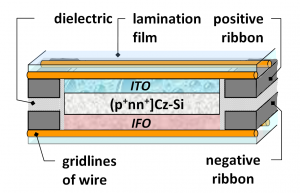
From left to right: senior researcher, PhD. Alla Chebotareva, senior researcher, PhD. Tatiana Kost, leading researcher, PhD. Gennady Untila.
The scientists of the Department of Microelectronics SINP Alla Chebotareva, Tatiana Kost, Gennady Untila proposed an innovative design of the solar cells - Laminated Grid Cell (LGCell) in order to cut the cost of the produced electricity. Their paper "Bifacial concentrator Ag-free crystalline n-type Si solar cell" was published in «Progress in photovoltaics: research and applications» (with impact-factor of 7.712). It's the first article published by this journal only by Russian authors.
The Leading Researcher of the Department of Microelectronics, PhD. Gennady Untila told us: "It is SINP where the LGCell design was discovered and now is developed. Its highlight is wires and films produced from a transparent conductive oxide; it is our profile. Our co-authors from the company "Solar Wind" manufacture diffusion silicon structures for LGCell, and the scientists from the Ioffe Physical Technical Institute are responsible for the correctness of the measurements of the solar cells parameters."
In the paper the authors explain that in order to reduce the cost of electricity produced by the crystal silicon solar cells it is necessary to produce them from Ag-free crystalline n-type Si as bifacial concentrators of diminished thickness. Why is it so?
The thickness is needed to be decresed because the price of Si plates amount to over a half of the solar module price. Bifacial solar cells will provide us a possibility to increase power-production of photo-electric systems for 10-50% using the backside. Light concentration by means of cheap lenses and reflectors improve power-production of photo-electric systems without extension of the surface of expensive solar cells. There are two reasons for preferable manufacturing of the solar cells from n-type Si: this material is less sensitive for the usual admixtures (for instance, Fe) and defects, and it is stable. Refusing from Ag comes from the increasing of its price. All these requirements are kept in the innovative design of Laminated Grid Cell.
LGCell consists of the electrodes produced from the films of the transparent conductive oxide (TCO) applyed to the both sides of the solar cells, which fulfil functions of antireflective and passivating coatings; and of a grid fixed to the TCO surface by low-temperature lamination (see Fig.1).
LGCell's contacts are symmetric (front and back sides) and it allows to manufacture bifacial solar cells and diminish their thickness with minimum risk of damage. They can be used for the solar cells produced from Si plates of both p- and n- types and provide combination of record low resistance and optical losses, which allows to use solar cells in low-concentration systems. Moreover, LGCell does not contain Ag.

Fig. 1. Bilateral concentration solar cell of the Laminated Grid Cell based on (p+nn+)c-Si structure with ITO (Indium Tin Oxide) coating on the p+ surface and IFO (Indium Fluorine Oxide) coating on the n+ surface, wire connecting block; cross buses are located near the solar cell.
The history of the increasing of the parameters of bifacial concentration solar cells of LGCell design is presented in Fig. 2. It is seen that during the last two years LGCells efficience for face illumination (ηF) was improved for 1% (from 16.6% up to 17.6%) and for backside illumintation (ηR) – for 3.5% (from 14.6% up to 18.1%)!

Fig. 2. The history of the improvement of the LGCell solar cells' efficiency for face illumintation (ηF) and backside illumintation (ηR), and maximum light concentration Сmax
The scientists have also compared the parameters of the LGCell and commercially available high-efficiency bilateral solar cell, produced of n-type Si (Reference Cell) under the conditions of concentrated light. The results are presented in Fig. 3. It is seen that at C = 1X LGCell provides lower efficiency than Reference Cell, but at C = 4–5X LGCell's efficiency is significantly higher.

Fig. 3. Efficiency vs light concentration for two solar cells produced of n-type Si: bilateral LGCell and commersially available high-efficiency bilateral solar cell (Reference Cell)
The reason is that the value of the series resistance of Reference Cell is twice lower. LGCell is more advantageous due to conducting coating and wire contacts.
The authors declare that there are no analogues for LGCells in the combination of bifacial and concentration properties.
